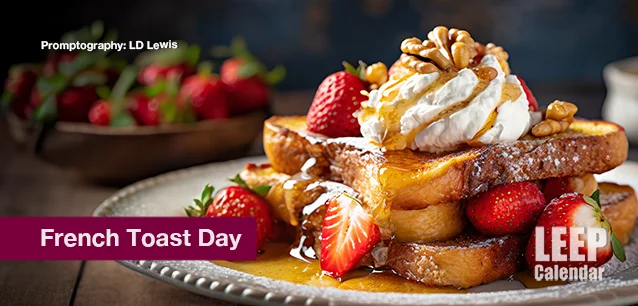 AD
AD
Today is: November 07
Scroll to explore events active on this date.
LEEP INK FEATURES

August? Absolutely!
In August, we live through the Dog Days of Summer. It's hot and often humid, and those who can leave for better climates do. Down south, winter is in full force. August is also known as "the ...

In The Heat of July: July 2025 Events
Is it hot enough (or cold enough if you're below the equator) for you yet? There is actually a day for that! Like every month, I pick a diverse collection of events you may or may not know about. This ...

May Blooms: Events in May 2025
Along with October, May is one of the most densely packed months of the year. It's before the summer humidity and the last whole month of the school year. The weather is warming in t...
About French Toast Day
Ends: Nov 28, 2024
DESCRIPTION:
French Toast Day celebrates the fourteen-hundred-year-old breakfast treat.
French toast, a popular breakfast dish enjoyed worldwide, has a history that predates the establishment of France itself. Known for its simple yet delightful combination of bread soaked in eggs and milk, then fried, French toast has been a staple in many cultures under various names.
The origins of French toast can be traced back to ancient times. The earliest reference to a similar dish is found in the Roman Empire, in a collection of recipes called "Apicius," dating back to the 4th or 5th century of the Common Era. This Roman version, known as "Pan Dulcis," involved dipping bread in a milk and egg mixture and then frying it.
Soaking bread in a liquid and frying it was not unique to the Romans; similar recipes surface across various cultures and eras, often to salvage stale bread. The dish we know as French toast appeared in medieval Europe, where it was known as "lost bread" or "pain perdu" in French, reflecting its origins as a way to use up stale bread.
The name "French toast" did not originate in France despite its association with France. The dish was known by different names in various countries: "Arme Ritter" in Germany, "Torrija" in Spain, and "Bombay toast" in India. The term "French toast" was first used in 17th-century England and later brought to America by early settlers. The reason behind the label "French" in English-speaking countries remains unclear. However, it may have been attributed to the dish's French popularity or simply as a way to lend the dish a sense of sophistication.
French toast's popularity grew in America, especially in the 19th and 20th centuries. It became a typical breakfast dish in American households and diners, often served with syrup, butter, fruit, or powdered sugar. Its ease of preparation and versatility contributed to its widespread appeal.
Today, French toast is a beloved breakfast food, with countless variations in different parts of the world. French toast remains a testament to the dish's adaptability and enduring appeal, from sweet toppings like maple syrup and fruit to savory versions with cheese and herbs.
VIDEOS
SUPPORTING DOCUMENTS
Currently, this event does not have supporting documents.
ADDITIONAL IMAGES
Currently, this event does not have supporting images.
Where would you like to go now?
 AD
AD


/footer-logo.svg)
